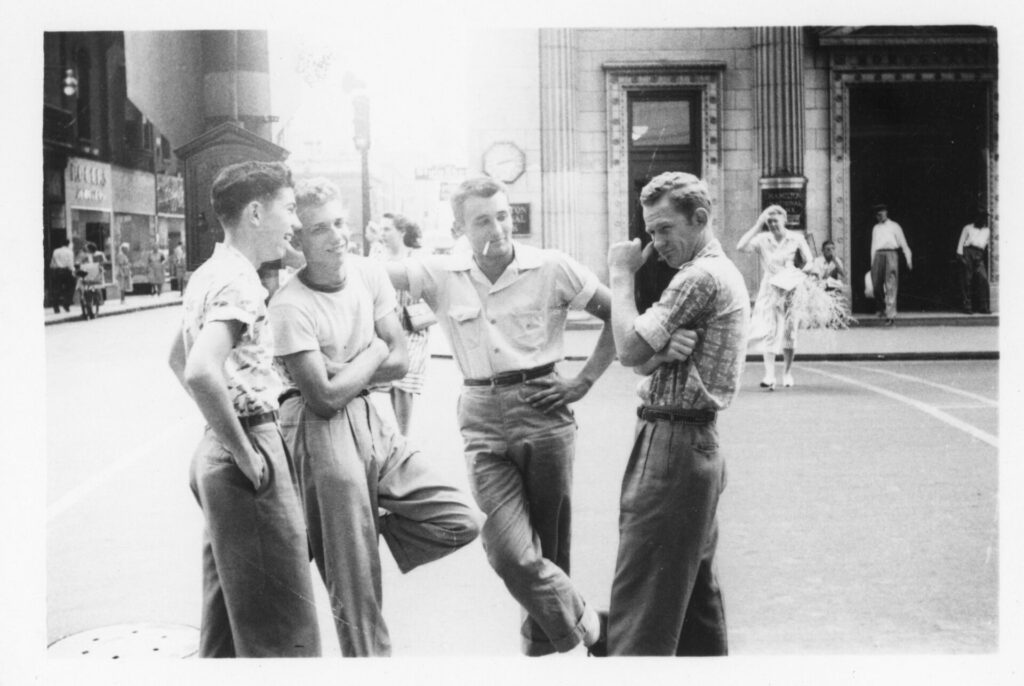Knoxville Shoebox Shares

Located on the northeast corner of W. Church Avenue and Market Street (then known as Prince Street), and designed by Knoxville architect Albert Baumann, construction on the Empire Building began in 1901. The Knoxville Journal and Tribune reported that “the building will be of the finest modern office construction with steel and concrete floors and roof, making it absolutely fireproof” an important distinction in the wake of the catastrophic 1897 fire on Gay Street. Replacing a residential dwelling on that corner, the new Empire building, once completed, claimed to be Knoxville’s tallest building, being nearly twice the height of the Deadrick building, its neighbor immediately to the north. The Empire Building was torn down in the 1970s. Shared by Alec Riedl.

The Rose Avenue School, located on Rose Avenue within what was then known as the West End and later Fort Sanders, operated from 1890 until 1915 when it was renamed the Staub School after former Knoxville Mayor Peter Staub. According to a history of the school, teachers were “assigned the task of educating the youngsters south of Cumberland Avenue and west of Second Creek” although in the early days it was a challenging environment, including part of it practically a slum area. A Miss Leah Fletcher, who served as Principal of Rose Avenue School (1902-1914) became known as the “Mother” of the Parent-Teacher Movement in Knoxville. The Staub School continued until 1957 when it closed following the opening of Fort Sanders Elementary. The old, some would say grim, building was used temporarily by Tennessee Medical College and even the fledgling private Webb School before the property was sold by the city to the University of Tennessee in 1959 which soon demolished it. Rose Avenue was later swallowed up by the expansion of the UT campus and the UT Aquatic Center on Andy Holt Avenue Drive at Volunteer Boulevard would be a modern day location point for the old school. Shared by Cindy and Mark Proteau.

First Christian Church, at North Gay Street and Fifth Avenue, is perhaps the only building designed by well-known Victorian architect George Barber and his son, Charles, working together. It was built between 1913 and 1915. George Barber (1854-1915), best known for his Victorian homes, died days after it was completed. Later that year, Charles Barber (1887-1962) co-founded the new and durable firm of Barber and McMurry. The church design, especially the six-pillar front, was reportedly inspired by famous New York architect Stanford White’s Madison Square Presbyterian Church in Manhattan; considering that church was later torn down, this might be considered a survivor of that aesthetic. It also got attention for its California-Spanish additions, including an unusual courtyard. First Christian used the church for almost a century before moving to a more modest building in a suburban location. Postcard shared by Cindy and Mark Proteau. This church is the first stop on KHP’s North Knoxville Driving Tour.

An early postcard of Ayres Hall, probably not long after its opening in 1921. Designed by Chicago architect Grant Miller, Ayres replaced the university’s original 1828 building, a Civil War-scarred relic known as Old College. At the time, the university was entirely clustered on the top of its famous Hill. Ayres Hall became the university’s iconic structure, and part of its tower design later inspired the checkerboard motif on UT’s Shields-Watkins Field, which was built simultaneously. Named for UT president Brown Ayres, who died in office during its construction, Ayres Hall makes a cameo in the 1970 film A Walk in the Spring Rain, starring Ingrid Bergman; in the movie, Ayres stands in for an unnamed Northeastern college. (Shared by Alec Riedl)

These photographs, circa 1938, shared by Walter Parry, offer rare glimpses of an unusual church, the People’s Tabernacle on East Cumberland Avenue near South Central Street. The church was founded and built in the 1890s by Rev. Robert Bateman, an Englishman who a Progressive Era reformer. He chose to put his tabernacle in the middle of the Bowery–known for saloons and brothels, it was Knoxville’s most dangerous neighborhood–as a refuge for people in need. Bateman had been on a mission concerning prison conditions in England in 1912 when he made a fateful choice to board a ship called the Titanic. He was among the hundreds lost. His funeral, held in this church and presided over by Bateman’s successor, Rev. W.E. Parry, was full to overflowing. The service featured the hymn “Nearer, My God, to Thee,” which Bateman was said to have asked the band to play as the ship was sinking.
The People’s Tabernacle remained here for almost a century more, ministering to the poorest of Knoxville. Displaced by Urban Renewal, in the 1950s, the church building was replaced by a simpler concrete structure nearby on Central that remains today, recently serving as a live-drama venue. Rev. Parry is shown with his son, Rev. William Moody Parry, who served as Assistant Pastor at the church during the 1930s (they’re Walter Parry’s grandfather and father, respectively). The group photo shows women who were involved at the church, standing by the old bridge that took East Cumberland over First Creek. The bridge is no longer there, and thanks to Urban Renewal and what became James White Parkway, East Cumberland no longer exists.

A summer scene on Market Square, looking north from Union Avenue, ca. 1929. At the left is the famous Market House, which stood in the center of the Square from 1897 to 1960. Most of the buildings on the right are still intact. Big umbrellas shielded farmers and shoppers from the sun. In the foreground, a farmer’s truck bears a load of watermelons. By July, the sheer bulk of melons from area farms demanded that the farmers’ market expand south to the 500 block of Market Street, which became known as Watermelon Row. Shared by Alec Riedl.

One of the first settlers to move into the area that would become Knoxville, former Revolutionary War veteran Captain James White built a homestead and a mill on the bank of the creek that flowed into the Tennessee River (now First Creek) around 1786. Later, he moved his family a short distance to a new site east along what is known today as Riverside Drive. This vintage postcard shows the marker that still exists there, erected by the local Bonny Kate Chapter of the Daughters of the Revolution in 1901. DAR members erected other historical markers around the city over the years, including those at Cavett’s Station and Campbell’s Station in West Knoxville. Shared by Alec Riedl.

Recently, D.J. Corcoran, archivist with the City Fire Department shared some historical images with us, including shots of the demolition of the old downtown Fire Station on Commerce Avenue at State Street. In the background of the vintage postcard (shared by Sam Furrow), is the ornate YMCA building, previously the Palace Hotel. That building caught fire in 1975, killing one person, and was soon demolished. In 1977, the Fire Department was razed too, to make room for road improvements along what became Summit Hill Drive. A bid by local preservationists to place the Fire Hall on the National Register of Historic Places was successful, but only two days after it was demolished.
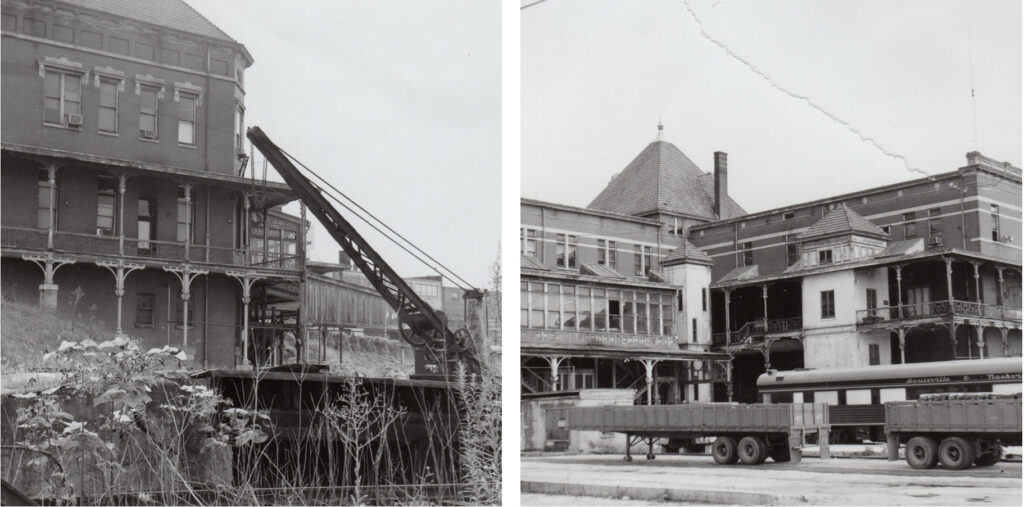
Photographer Ros Mol took these shots of the L&N Station during the early 1970s. One of two passenger railway stations in Knoxville, the L&N saw its last regular passenger train leave in 1968. Knoxville’s World’s Fair in 1982 brought new life to the old station when it was converted to house restaurants, including a Ruby Tuesday. The train station was renovated again and reopened in 2011 as the L&N STEM Academy, operated by Knox County Schools. The derrick pictured still stands today adjacent to the school.

Since January, we have been highlighting our growing digital collection monthly in West Knoxville Lifestyle magazine. Reader Joe Parrott saw a picture of a Coca Cola mural painted on the side of a downtown building during the 1930s from KHP’s Post Sign Company collection. Knoxville Coca Cola had been available in Knoxville in the late 1800s, but only as a fountain drink. That changed here locally when James Patrick Roddy, Sr. began bottling it by hand around 1904. By the 1930s, images of attractive women were used to promote the now ubiquitous soft drink, as seen here on the corner of Clinch Avenue and Locust Street. Mr. Parrott recognized the mural as one painted by his grandfather R.W. Dick, who painted many outdoor signs in Knoxville and Atlanta. The other photo below shows Mr. Dick (on far right) with his company, Dick and Anderson, which also produced the original lighted signs for the Tennessee Theatre when it opened in 1928, as well as animated signs for Coca Cola.

This photograph from the Post Sign Company collection looks in a southeasterly direction from the Broadway viaduct toward the spire of the Immaculate Conception Catholic Church on Summit Hill, formerly Gallows Hill in the 1930s. The houses seen to the right of the church on the bluff are now all gone, replaced by Ryan’s Row townhouses in the 1980s and the new condominiums known as City House Town Homes. The Crane company building in the foreground and the larger C.M. McClung Warehouses, adjacent to the left, were poised for redevelopment before they caught fire and burned down in two enormous blazes early in this century.

In the late 1800s, German immigrant Peter Kern was a prominent baker and confectioner, locally famous for his amazing emporium, which featured a candy shop, a toy store, a soda fountain, and an “ice-cream saloon.” One of the first buildings designed by influential architect Joseph Baumann, the 1876 building still stands at the southwest corner of Market Square where Tupelo Honey and the Oliver Hotel are today. The hotel’s “Peter Kern Speakeasy” features his portrait. The popular Kern, who lived around the corner on Walnut Street with his German-born wife, Henrietta, was elected mayor in 1890. Kern died in 1907, but his company later built a prominent bakery on Chapman Highway, now being rehabbed to combine residences with retail.
This 1913 illustrated letterhead proclaiming Kern’s to be the “The Great ‘Package Candy House’ of the South” was shared by Cindy and Mark Proteau.

Looking north on Walnut Street from in front of St. John’s Episcopal Church around the early 1900s. The first iteration of St. John’s was originally built here in 1862 and remodeled in the 1890s. Further down the road on the left, the Second Presbyterian Church (now on Kingston Pike just west of Neyland Drive) is already in its second downtown location. Today, Lawson McGhee Library stands on this spot. Although not in the picture, the southerly portion of Walnut Street, as it leads to Main Street, is a slight dog leg around the Park House—just like it is today. For this reason, Walnut was formerly called Crooked Street. Shared by Alec Riedl.

The nomadic Knoxville Firefighters Memorial, erected in 1905, has stood in at least four places around downtown. Originally, the memorial stood on Main Street outside the Knox County Courthouse before moving to Emory Park, adjacent to Fire Station #3. After that firehall was closed in the 1940s, the memorial moved to a spot in front of City Hall at the intersection of Western and Henley Street (Lincoln Memorial University’s law school now occupies that site.) However, when it went on display at City Hall, a new lantern was fabricated and added to the fireman’s right hand, as you can see here. An electrical cord allowed the light to shine at night. When the memorial was later moved across the street, where it now stands in front of the downtown fire station on Summit Hill, the lantern was removed. This photograph, from the Knoxville Fire Department’s 1975 annual, which contains a fascinating short history of the Knoxville department, was shared by Cindy and Mark Proteau.

This photograph, looking north along the 400 block of Gay Street probably around 1935, is part of the Post Sign Company Collection in KHP’s archives. The collection comprises more than 100 photographs of street scenes throughout downtown and the suburbs depicting examples of Post Sign’s marquees and advertisements. The J.C. Penney store—which was visited at least once a year by Mr. J.C. Penney himself—did business here for more than 50 years. Today, the building is occupied by multiple businesses, notably the Maple Hall bowling lanes and the restaurant Babalu, reopening this year with a different interior. In the background is the Union Bus Terminal, a busy bus station for multiple lines connecting to all parts of the country. It included an “Arcade,” enclosed shopping center was something like what we were later call a mall. The terminal and arcade which figure in Cormac McCarthy’s novel, Suttree, had been torn down by the 1960s, and the space has been empty since, though recently the subject of new development.

Amy Vineyard has been delving into her own shoeboxes and shared this unusual postcard pack with us. The front depicts a view across the Tennessee River looking towards downtown. The date is around 1905, not long after the fourth, and current, Gay Street Bridge was built in 1898, and shortly after outlaw Kid Curry fled across the bridge on a stolen horse after he had escaped from jail. A cluster of buildings, now long gone, line Front Street (later Neyland Drive), but the most visible building is the Knox County Courthouse, the center part of which forms the Courthouse that we know today. The spire to the right of the Courthouse belonged to the old First Baptist Church on the 600 block of Gay Street (it moved to its current location on Main Street in 1924). Given the age of the photograph, the sternwheeler towboat, perhaps the Oliver King, is pushing a barge downstream. A flap on the front of the postcard opens up to reveal a strip of 12 individual images, including one of the Immaculate Conception Catholic Church and beside it, St. Mary’s School, which was demolished around the 1970s.

Reader, Greg O’Connor, a former student there shared the following comment with us: “The back part of the building (darker shade) was the school and the front part (lighter shade) was a convent where the nuns who taught us lived. There was a convent where the nuns who taught us lived. There was a cafeteria under the church where we ate lunch each day.

Here’s a snapshot, ca. 1960, that hints at the cultural diversity of South Central Street. After World War I, most of the clientele of the block were African American, but many of the shops themselves reflected the immigrant roots of the shipowners. At left, Frank’s Place was a sandwich shop run by Frank Provenza, a member of one of two Sicilian families who did business on this block. At right is the SLOC store—the acronym for Spend Less On Clothes, but the owners, a Jewish Lithuanian family, enjoyed the inside joke that Schlock is Yiddish for junk. That certainly didn’t describe everything they sold. The SLOC store was one of the best places in town to find the latest R&B and early rock ’n’ roll music. Frank’s Place is now the Pretentious Beer Glass Co., the SLOC store the Underground part of the lamented Crown and Goose. Shared by Gerald R. North. You can read a short biographical piece by Gerald and growing up in Knoxville in the 1940s our Oral History Conservations page at: https://knoxvillehistoryproject.org/growing-up-in-knoxville-by-gerald-r-north/

Complementing our look into the founding of Tennessee, this postcard showing the interior of Blount Mansion was published by Jim Thompson (a recent subject of our weekly Zoom talks) likely in the 1930s when he, along with many others, was promoting the new national park just beyond Knoxville. According to the reverse of the postcard, “The furniture is old pine, with the exception of the open Dutch cupboard on the right – it’s of wild cherry and was found in the heart of the Great Smoky Mountains.” Blount Mansion is the only building registered in the city as a Historical National Landmark. Postcard shared by Alec Riedl.
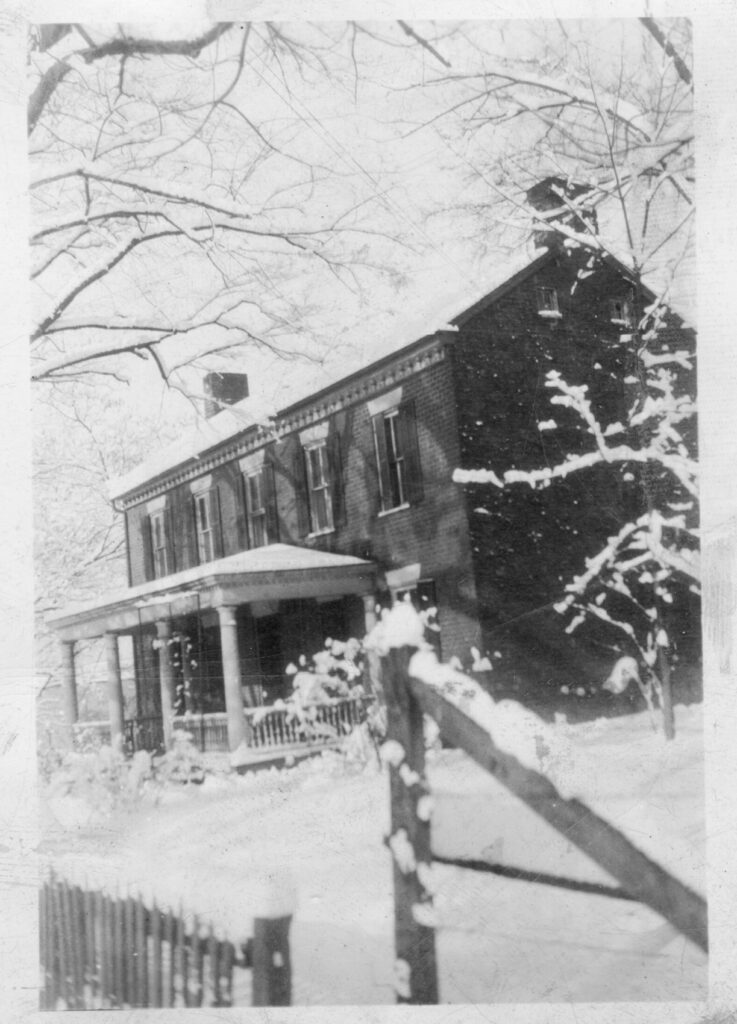
Mellen House in the snow on Kingston Pike, circa 1940 shared by Mary Mellen Clark. During research for our Historic Bearden book, we met with Mary Mellen Clark whose family lived in an old house, a prominent abode on Kingston Pike on the edge of Bearden, first known as the Henry Lones House and also the “Four-Mile House” given its distance from downtown. Prof. George Mellen and his wife Mary purchased it in the late 1800s. Prof. Mellen taught French and Greek at UT while Mary was known to lecture on the Civil War. The steep residential drive across the street named Mellen Drive is named after them. This photograph was taken circa 1940, not long before it was torn down. It would have stood at the east side of the entrance to Western Plaza.

Knoxville was once notable for pork, and in the season of Christmas hams, this week we’re sharing this ca. 1930 image of this once well-known South Knoxville plant. East Tennessee Packing Co. was best known for its store brand, Selecto. It was on the south side of the river, just west of Suttree Landing. Shared by Sam Furrow.

Two interesting photographs shared by Jackie Willard, who is a frequent participant in our weekly Zoom talks. Now living in Nashville, Jackie was inspired to contact us after our talk on Knoxville Presidential visits. Jackie shared a selection of photos with us after joining us for numerous Zoom talks, particularly Presidential Visits in Knoxville. Her parents were supporters of Senator John F. Kennedy and helped champion his visits to Knoxville in the late 1950s before he became President in 1961. These photos show Jackie’s father (who at one time lived in the Glencoe apartment building on State street) and pals on Gay Street across from the Holston Building, then serving as Hamilton National Bank. Across Clinch Avenue is the corner of the mid-19th century Fouche block, raised in the 1980s, and rebuilt in the following decade to house the East Tennessee History Museum, Knox County Arches and the McClung Historical Collection. The shot of the Tennessee Theatre showing Key Largo helps date that shot, and perhaps both photos, to 1948 when the film was released.
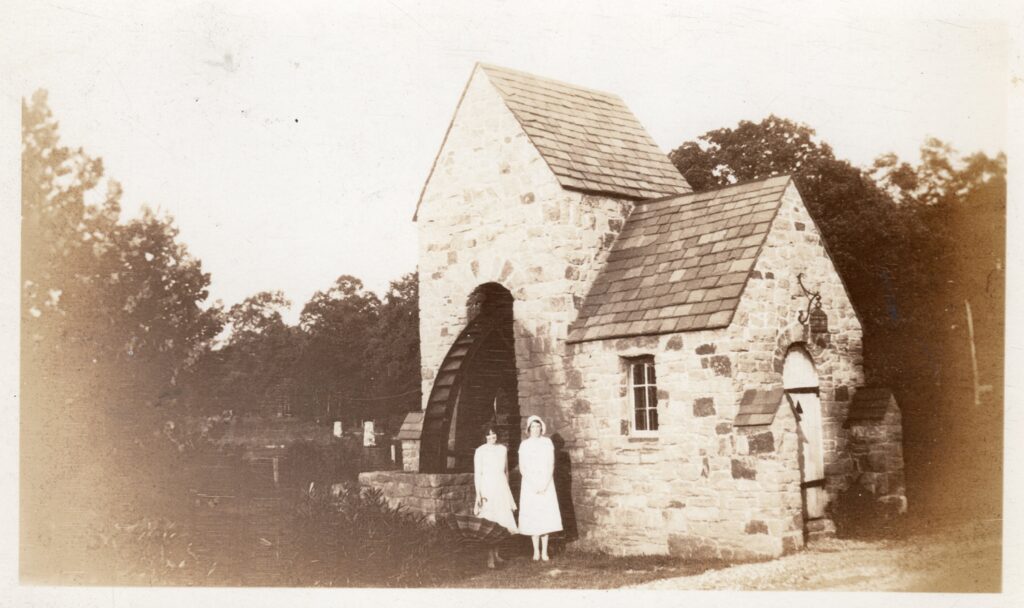
Sally Guthrie shared this photograph of the Westmoreland Water Wheel during the 1920s when the neighborhood, on the fringe of Bearden, was still new and still growing. As featured in our Historic Bearden book, the water wheel was designed by Charles Barber in 1923 for Judge D.C. Webb before any of the houses in the new development were built.

A festive image of the old New Knoxville Brewing Co., probably in the late 1890s, showing their pride in their Bock beer. The biracial staff appears to be preparing for a parade. This elaborate plant, which was connected to a deep artesian well and turned out 12,000 barrels of beer annually, was located along Second Creek between downtown and Mechanicsville. After a post-prohibition effort to revive it in 1937 came to naught, it was torn down for I-40 construction. The approximate site has most recently been a homeless camp. Shared by Bernie Wallace.

Here is a shot likely taken in the 1940s, one from atop the railroad overpass on Northshore Drive, which was a new road then. Is that a 1940 Cadillac convertible? Shared by Jeran Guffey.
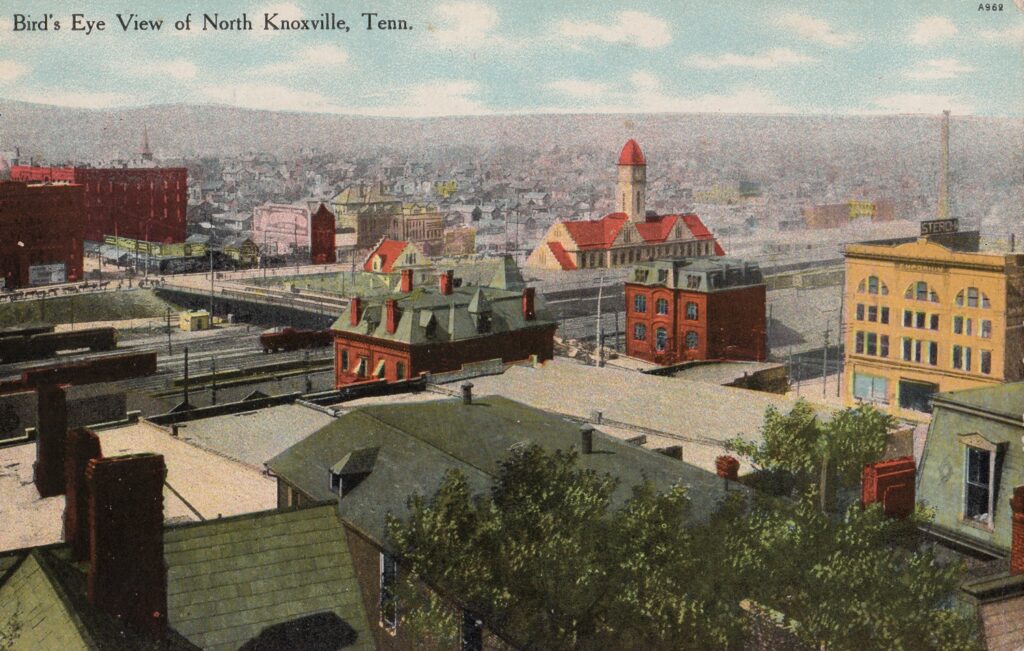
Bird’s Eye of North Knoxville (Lib Cooper Knoxville Digital Postcard Collection/KHP) This bird’s eye view postcard from around 1905—looking northward perhaps from the top of Immaculate Conception Catholic Church—shows a scene that has not quite vanished. The yellow building to the right is the Emporium Building, which still stands at Gay and Jackson—it was then Sterchi Brothers’ main store. The now-unfamiliar red buildings to its left were the old railroad office buildings. They stood on either side of Gay Street, but were torn down in the 1970s. The perhaps more familiar building with the clock tower is the old Southern Railway station—but the tower is unfamiliar, because it was torn down about 75 years ago, leaving the rest of the building below it. To the upper left is a somewhat surprising scene: the Watauga Hotel and the Central Hotel are there, but the 1910 Atkin Hotel hasn’t been built yet. They were all torn down in the 1960s, except for the lower part of the Watauga, which became known as Regas Restaurant, now remodeled as the Alliance for Better Nonprofits. All the buildings in the foreground–the roofs of mostly stylish hilltop residences along West Vine—vanished many years ago. Shared by Adrienne Webster.

This statue, here seen on a vintage postcard on Main Street in front of the old courthouse, was erected in 1905 as a memorial following the deaths of Captain William Maxey and fireman John Dunn who lost their lives the previous year battling a serious fire on Gay Street. The statue has moved around town several times since then, first moving to Emory Park adjacent to the former North Knoxville Fire Station #3. The statue then moved to City Hall grounds that now form the Duncan School of Law campus for Lincoln Memorial University. Its final move to date was its shortest yet – right across the street in front of the Downtown Fire Station on Summit Drive.
An inscription on the base of the statute reads, “In memory of firemen who made the supreme sacrifice answering their last alarm.” One of those names was Chief Sam B. Boyd, who served as Fire Chief for 29 years before he died of a heart attack in 1929 while directing his men attempting to extinguish a fire at the Knoxville Business College. Boyd is the only Fire Chief who has died in service. The old fire engine inside the adjacent exhibit building also features Boyd’s name. Shared by Chad Cooper.

A view, likely looking west, of gladioli fields at Baum’s Home of Flowers in Bearden in 1918. Baum’s industrial-size facility, reportedly to be the largest commercial greenhouse in the southeastern United States, produced flowers in overflowing abundance, including, at its peak, 3.5 million roses a year. This unused photograph from KHP’s recently published book Historic Bearden (you can order the book HERE) was shared by Charles Baum.

Over There!
Recognize anybody? This is a crowd scene from Gay Street, 103 years ago this week, family and friends seeing off their favorite recruits as they left on the Southern Railway for training at Camp Sevier in South Carolina, many of them bound eventually for Europe, and trench warfare. It’s apparently the steeply hilly old 100 block, just a year or two before the viaduct raised it to a more perfect flatness, covering up the lower floors of several buildings in the process. It’s safe to say that about a year later, many of the people in this photograph, in and out of uniform, were coming down with something they called the Spanish Flu. That lethal virus was responsible for the deaths of about 200 Knoxvillians, not counting the soldiers who caught it in Europe. Shared by Cindy and Mark Proteau.
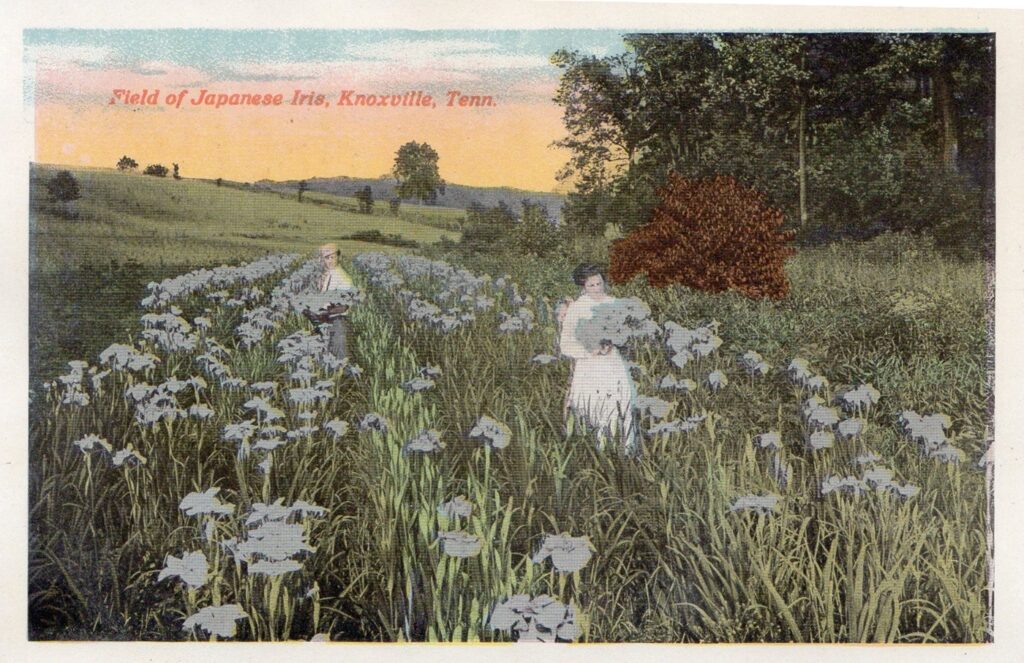
An idyllic summer scene of Japanese Irises, photographed somewhere in Knoxville, for an early 20th-century postcard. It was the suffrage era, but we can only guess at this unknown woman’s sympathies. Shared by Sam Furrow.

This week we have a shot looking west along Kingston in the heart of Bearden. Notable businesses include the Capri Theatre (now Bennett Gallery) and the former Shoney’s Big Boy on the south side of the Pike. This slide is part of a collection held by Bearden-native Bradley Reeves from his ever-expanding Appalachian Media Archives, which collects local history gems and also performs transfers of old film footage, VHS tapes, and more. If you’re cleaning out your basement during the pandemic and need his services, contact Bradley at https://www.facebook.com/AMArchive

One of Knoxville’s biggest industries of the Victorian era was Brookside Mills, which opened near Second Creek, just west of Central near Baxter, in 1885. A weaving mill as opposed to a knitting mill, it employed more than 1,000 workers, many of whom lived nearby in what’s now Old North. Considered progressive in its day, it offered day care for workers’ children, and a green landscaped courtyard for their enjoyment on breaks. Brookside was the reason the family of Clarence Brown, the future Hollywood director, came to Knoxville; his dad, Larkin Brown, was once plant manager. It closed in the 1950s, and the factory has since been demolished. Vintage postcard shared by Chad Cooper.

This vintage postcard, shared by Cindy and Mark Proteau, shows the YWCA building on the corner of Clinch Avenue and Walnut Street. Completed in 1925, the new building replaced a former doctor’s house, which originally served as the organization’s headquarters. According to research by historian, Laura Still, a cornerstone was laid containing a history of the local YWCA, related newspaper articles, a pamphlet about the proposed Great Smoky Mountains National Park, a list of 300 building workers, and on the top, an open Bible. An inscription clearly visible on the building reads, “DEDICATED TO THE GLORY OF GOD AND THE SERVICE OF WOMANHOOD, 1925.” Its star turn came in 1999, when its lobby appeared in the major motion picture October Sky, starring a young Jake Gyllenhaal. It portrayed a hotel in Indianapolis.

This blurry early snapshot shows a congested Clinch Avenue, looking east from Market Street, with ca. 1920 automobiles, parked bicycles, with an electric streetcar approaching. On the right is the marble Custom House, which then housed the city’s main post office. In the background is the surprisingly lean Burwell Building, before its 1927-1928 additions, which would include the Tennessee Theatre. The mid-19th-century building known as the Fouche Block was the subject of a preservation effort, but was demolished in 1993 for a construction project that never came to fruition. The East Tennessee History Center later expanded into the site. This photograph comes from a series of images from the Post Sign Company, now part of KHP’s expanding digital collection.

This is a relatively rare postcard depicting a landmark central to the African American community. The “Colored High School” was the name of Knoxville’s public school for black students, built in 1915 on old Payne Avenue, just east of downtown. Designed by Albert B. Baumann, Sr., it replaced the original Austin High, which was on Central, near the old “Bowery” saloon district. This 1915 school, which accommodated both elementary and high-school students, was quickly overcrowded. The old name was revived in 1928, when a new high school was built on Vine Avenue, and survived in the combined black and white high school known as Austin East. This building no longer exists, and in fact Payne Avenue itself was erased during urban renewal in the late 1950s. (Postcard shared by Cindy & Mark Proteau)

Located on the northeast corner of Gay Street and Clinch Avenue, the Imperial Hotel was one of several hotels on this spot. The Imperial was an elaborate remodel of a prior hotel was known as the Hattie House, finished by 1880, whose whose early guests included legendary abolitionist Frederick Douglass. The high-Victorian Imperial Hotel, which included a posh restaurant, a basement bowling alley, and a lobby with original paintings by Lloyd Branson, was destroyed by a lightning fire in 1916. In its place, the larger Hotel Farragut was finished in 1919. The Farragut remained as a hotel into the 1970s and later served other purposes before it was restored by Rick Dover and re-opened as Hyatt Place in 2018. Photo Credit: Imperial Hotel on gay Street (Sam Furrow Knoxville Digital Postcard Collection)

Linda Lee loaned us some of her personal photos through our Shoebox Shares appeal, and perhaps the most startling is this undated shot of internationally popular crooner Perry Como with Linda’s grandmother, Leta C. Parker (widow of one of the original owners of Parker Brothers), at now-defunct Deane Hill Country Club. Como came several times in the 1970s to compete in the Chet Atkins Celebrity Invitational Tournament, always held in early June.

As Knox County reopens for business, we thought we’d show this cheerful springtime postcard of the old 1885 courthouse, shown as it was in the 1930s. In nice weather, the courthouse windows would be open, and interesting trials would sometimes draw a crowd to listen on the lawn. In this centennial year of Women’s Suffrage, we may remember this as the site of a dramatic talk by San Francisco-born suffragist Maud Younger, who in November, 1917, spoke to an enthusiastic crowd of 500, defying a sheriff’s order to keep her out of the courthouse itself–after she’d also been banned from the Market House. She gave her full speech from the courthouse steps. This setting has changed little since this photograph was taken, except that the trees are bigger. Shared by Adrienne Webster from the Lib Cooper Knoxville Postcard Digital Collection.

When it opened just south of the Henley Bridge in 1936, the Smoky Mountain Market on Chapman Highway may have appeared to be just another convenience store. But one of the store’s most popular items, the hotdog (added almost as an afterthought) was so popular it contributed to the store’s longevity.
According to a store press releases celebrating its 50th anniversary in 1986, those original five cent hotdogs were cooked on a steaming hot kettle in the back of the store and, and over the years, drew locals by the score. A few celebrities came in for them too, including Conway Twitty, Senator Howard Baker, the Harlem Globetrotters, and one time the entire Brady Bunch. Porter Waggoner, a vegetarian, also came in on occasion when he stayed at a motel across the road.
After being owned by Howard J. Johnson for many years, local businessman Virgil Rushing bought the store in 1974 and created a chain of 31 Smoky Mountain Markets. But the Chapman Highway Store remained the “Old Number One” until it closed in 2002.
Shared by Todd Rushing.

Open in 1902, Knoxville General Hospital, the first big hospital ever built in Knoxville, was located just northwest of downtown. It was central to the Spanish flu epidemic of 1918, which afflicted over 8,000 Knoxvillians and stressed the hospital’s capacities. It also played a role in dealing with other disasters, like the 1904 New Market train wreck. Knoxville General is remarkable in women’s history in that its earliest superintendents were women, who had critically responsibilities here even before they could vote.
It closed in the early 1950s, when many of its roles were taken over by the new UT Hospital. Today, the Knox County Health Department’s location on Dameron Avenue occupies part of old Knoxville General’s campus. Shared by: Chad Cooper.

An unusual color postcard image of the Clinch Avenue Viaduct over Second Creek and the L&N rail yards, looking northeast toward downtown probably not long after its construction in 1905. Although based on a photograph, with the real L&N loading areas to the left, and an electric streetcar approaching, some of the skyline background appears to be painted in, perhaps showing buildings other than those that were really visible from this location. The blossom motif, perhaps inspired by dogwoods, has remained in the rebuilt viaduct used today. Shared by Chad Cooper.

The Jackson Avenue brick-lined ramp, recently removed for replacement, was built in 1919 to access the newly raised portion of Gay Street. In this photo from 1974, by newcomer Ros Mol, the unfamiliar brick buildings at left are the old railroad headquarters, built originally for the Knoxville-based East Tennessee, Virginia, and Georgia Railroad—which, in 1894, became a main component of J.P Morgan’s new Southern Railway. Although much admired in photographs today, the two 1880s Second Empire buildings were torn down by Southern with little comment in the latter 1970s.

The Negro Building, designed and built by staff and students of Knoxville College, was a feature of the famous 1913 National Conservation Exposition at Chilhowee Park. Knoxville’s biggest event before the 1982 World’s Fair, it drew one million visitors over a two-month period. The Negro Building was intended to highlight the accomplishments of black people in East Tennessee. Bricks were made expressly for the building by KC students, and wood was cut from a forest owned by KC. Like all the other dozen or more fair buildings, it vanished in the years after the fair, probably due to fire. This vintage postcard was kindly shared by Cindy and Mark Proteau.

The “bird’s eye” perspective is interesting because at the time the Wright Brothers’ new invention had never been seen in Knoxville. The fine print notes that it was taken from the top of the flagpole of what was then Knoxville’s tallest building, the newly completed Knoxville Banking and Trust Building, later known as the Burwell. The Gay Street Bridge we use today is there, as is the central part of the familiar Knox County Courthouse, without its wings. The spire in the foreground, once Knoxville’s tallest structure, belongs to the old First Baptist Church, demolished in the 1920s. Visible just behind it is a rare long view of Staub’s Theatre, then primarily a vaudeville venue—across the street from the Lamar House, which appears not yet to have a Bijou Theatre behind it. The Schubert Hotel, the Victorian landmark this side of the Lamar House, featured a small corner tower; it all that burned down in the 1940s. And most prominent in the image is the large barrel-roofed building once known as the Municipal Auditorium. A failure in its original role, it later served as a skating rink and still later as a streetcar barn. It was torn down in the early 1950’s. This vintage postcard was kindly shared by Cindy and Mark Proteau.



